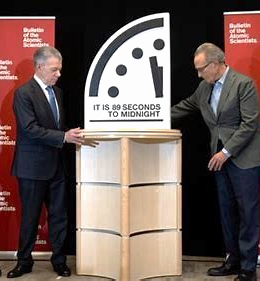The Doomsday Clock, maintained by the Bulletin of the Atomic Scientists, serves as a symbolic representation of the proximity of humanity to existential catastrophe. The clock’s periodic updates reflect current threats, including nuclear tensions, climate change, and emerging technological risks. This paper examines the latest update to the Doomsday Clock, analyzing its implications and the global response to impending dangers.
Introduction
Since its inception in 1947, the Doomsday Clock has been a critical barometer of global security and stability. It represents an aggregation of expert opinions on existential threats facing humanity. Over the decades, the clock has moved forward and backward in response to shifting geopolitical and environmental conditions. The latest update, issued in 2024, reflects an assessment of contemporary global risks, including military conflicts, climate crises, and disruptive advancements in artificial intelligence.
Current Update and Rationale
The 2024 update of the Doomsday Clock places humanity at its closest point to midnight, signifying an unprecedented level of global peril. The key factors influencing this adjustment include:
- Geopolitical Instability: Rising tensions between nuclear-armed states, including heightened hostilities in Eastern Europe and the Asia-Pacific region, have significantly increased the risk of nuclear confrontation.
- Climate Change Acceleration: The continued rise in global temperatures, coupled with extreme weather events and inadequate international response, has further exacerbated ecological instability.
- Biological and Technological Risks: Advances in artificial intelligence, coupled with concerns about biosecurity and the potential misuse of synthetic biology, have introduced new existential threats.
- Erosion of International Norms: The weakening of global institutions and arms control agreements has contributed to an unstable and unpredictable international landscape.
Implications of the Update
The adjustment of the Doomsday Clock serves as a stark reminder of the urgent need for coordinated global action. The following implications emerge from the latest update:
- Policy and Governance: Nations must prioritize diplomatic efforts, arms control agreements, and multilateral cooperation to mitigate existential risks.
- Climate Action: Rapid decarbonization, investment in renewable energy, and adherence to climate accords are essential to curbing global warming.
- Technological Safeguards: Ethical AI development and regulatory oversight are necessary to prevent unintended consequences of emerging technologies.
Global Response and Future Prospects
The response to the Doomsday Clock update has been mixed, with some nations and organizations calling for urgent policy shifts, while others remain entrenched in geopolitical rivalries. The path forward requires collective action, scientific innovation, and strengthened international institutions to navigate these unprecedented challenges.
Conclusion
The Doomsday Clock remains an essential tool in assessing humanity’s proximity to self-destruction. The latest update underscores the pressing need for global cooperation and strategic interventions to prevent catastrophe. The trajectory of the clock will ultimately depend on humanity’s ability to address these existential threats through collective resolve and decisive action.
References
- Bulletin of the Atomic Scientists. (2024). Doomsday Clock Statement.
- Intergovernmental Panel on Climate Change (IPCC) Reports.
- Reports on global security and arms control agreements.
- Ethical guidelines on artificial intelligence and emerging technologies.

By: Donte Nelson



